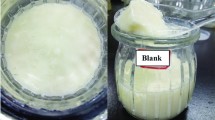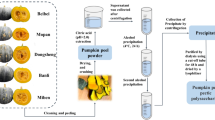Abstract
This paper deliberates the extraction, characterization and examination of potential application of soluble polysaccharides of palm kernel cake (PKC) as a prebiotic. The PKC was defatted and crude polysaccharide was obtained through water, citric acid or NaOH extraction. The physiochemical properties of the extracted polysaccharides viz. total carbohydrates, protein content, solubility rate, monosaccharides composition, structural information and thermal properties were also determined. The extracted soluble polysaccharides were further subjected to a digestibility test using artificial human gastric juice. Finally, their prebiotic potential on two probiotics, namely Lactobacillus plantarum ATCC 8014 and Lb. rhamnosus ATCC 53103 were evaluated in vitro. It was observed that PKC contained ash (5.2%), moisture (7.4%), carbohydrates (65.8%), protein (16.5%) and fat (5.1%). There were significant differences (P < 0.05) between the values of NaOH-extracted crude polysaccharides (8.73%) and that of water (3.03%) and citric acid (3.07%)-extracted polysaccharides. The extracted polysaccharides composed of mannose, galactose, glucose, arabinose, xylose and rhamanose, with highest percentage of mannose (62.49%) and galactose (25.42%) in SPCA. Total carbohydrate content in SCPW, SCPCA and SCPN are 57.11%, 56.94% and 50.95%, respectively. The polysaccharides from PKC in this study were found to be highly soluble (> 95%). Protein content in SCPW, SCPCA and SCPN are 0.72, 0.40 and 0.58, respectively, and the peaks which indicated the presence of protein were observed at approximately 1640 cm−1 (amide I). FTIR spectroscopy revealed that the polysaccharides extracts were linked to β and α-glycosidic bonds and thermal analysis using differential scanning calorimeter (DSC) showed the main degradation temperature of SP is about 121 to 125 °C. The SP were found to be highly resistance (> 96%) to hydrolysis when subjected to artificial human gastric juice. The prebiotics potentials of the polysaccharides on probiotics in vitro demonstrated an increase in proliferation of Lb. plantarum ATCC 8014 and Lb. rhamnosus ATCC 53103 with decrease in the pH of the medium and producing organic acids.All the above findings strongly indicated that polysaccharides extracted from PKC, an industrial waste, have a potential to be exploited as novel prebiotics.





Similar content being viewed by others
References
Abbasiliasi S, Tan JS, Ibrahim TAT, Ramanan RN, Vakhshiteh F, Mustafa S, Ariff AB (2012) Isolation of Pediococcus acidilactici Kp10 with ability to secrete bacteriocin-like inhibitory substance from milk products for applications in food industry. BMC Microbiol 12:260
Alimon AR (2004) The nutritive value of palm kernel cake for animal feed. Palm Oil Dev 40:(12–16)
Al-Sheraji SH, Ismail A, Yazid M, Mustafa S (2013) Prebiotics as functional foods: a review. J Funct Foods 5:1542–1553
Al-Sheraji SH, Ismaila A, Manap MY, Mustafa S, Yusofa RM, Hassan FA (2012) Fermentation and non-digestibility of Mangifera pajang fibrous pulp and its polysaccharides. J Funct Foods 4:933–940
AOAC (2003) Official methods of analysis vol 18th ed. AOAC, Washington
AOAC (2005) Official methods of analysis vol 18th ed. AOAC, Washington
Ares G, Gime ́nez A, Ga ́mbaro A (2009) Consumer perceived healthiness and willingness to try functional milk desserts. Influence of ingredient, ingredient name and health claim. Food Qual Prefer 20:50–56
Aspinal GO (1970) Polysaccharides. Pergamon Press, New York
Azmi AFMN, Mustafa S, Hashim DM, Manap YA (2012) Prebiotic activity of polysaccharides extracted from Gigantochloa levis (Buluh beting) shoots. Molecules 17:1635–1651
Ballesteros LF, Cerqueira MA, Teixeira JA, Mussatto SI (2015) Characterization of polysaccharides extracted from spent coffee grounds by alkali pretreatment. Carbohyd Polym 127:347–354
Baseri MK, Baker S (2011) Identification of cellular components of medical plants using FTIR. Roman J Biophys 21:277–284
Bothara SB, Singh S (2012) Thermal studies on natural polysaccharide. J Trop Biomed 2:1031–1035
Capek P, Sasinkova V, Wellner N, Ebringerova A, Kac M (2000) FT-IR study of plant cell wall model compounds: pectic. Polysacch Hemicellul 43:195–203
Cerqueira MA, Souza BWS, Simões J, Teixeira JA, Domingues MRM, Coimbra MA, Vicente AA (2011) Structural and thermal characterization of galactomannans from non-conventional sources. Carbohyd Polym 83:179–185
Chen Y, Xie MY, Nie SP, Li C, Wang YX (2008) Purification, composition analysis and antioxidant activity of a polysaccharide from the fruiting bodies of Ganoderma atrum. Food Chem 107:231–241
Dairo FAS, Fasuyi AO (2007) Evaluation of fermented palm kernel meal and fermented copra meal proteins as substitute for soybean meal protein in laying hens diets. J Central Eur Agric 9:33–47
Du B, Song Y, Hu X, Liao X, Ni Y, Li Q (2011) Oligosaccharides prepared by acid hydrolysis of polysaccharides from pumpkin (Cucurbita moschata) pulp and their prebiotic activities. Int J Food Sci Technol 46:982–987
Dubois M, Gilles KA, Hhamilton JKPAR, Smith F (1956) Colorimetric method for determination of sugars and related substances. Anal Chem 28:350–356
Dusterhoft EM, Voragen AGJ, Engels FM (1991) Non starch polysaccharides from sunflower (Helianthus annuus) meal and palm kernel (Elaeis guineenis) meal preparation of cell wall material and extraction of polysaccharides fractions. J Sci Food Agric 55:411–422
Gan C-Y, Latiff AA (2010) Optimisation of the solvent extraction of bioactive compounds from Parkia speciosa pod using response surface methodology. Food Chem 124:1277–1283
Gannasin SP, Adzahan NM, Hamzah MY, Mustafa S, Muhammad K (2015) Physicochemical properties of tamarillo (Solanum betaceum Cav.) hydrocolloid fractions. Food Chem 182:292–301
Gibson GR, Probert HM, Loo JV, Rastall RA, Roberfroid MB (2004) Dietary modulation of the human colonic microbiota: updating the concept of prebiotics. Nutr Res Rev 17:259–275
Goderska K, Nowak J, Czarnecki Z (2008) Comparison of the growth of Lactobacillus acidophilus and Bifidobacterium bifidum species in media supplemented with selected saccharides including prebiotics. ACTA Sci Pol Technol Aliment 7:5–20
Graham H, Gron Rydberg MB, Aman P (1988) Extraction of soluble fiber. J Agric Food Chem 36:494–497
Grigelmo-Miguel N, Martin-Belloso O (1998) Characterization of dietary fiber from orange juice extraction. Food Res Int 35:355–361
Havilah ED, Morris WR, Woolnough J (1977) A microcalorimetric method for determination of ammonia in Kjeldahl digests with a manual spectrophotometer. Lab Pract 26:545–547
He Z, Wang X, Li G, Zhao Y, Zhang J, Niu C, Zhang L, Zhang X, Ying D, Li S (2015) Antioxidant activity of prebiotic ginseng polysaccharides combined with potential probiotic Lactobacillus plantarum C88. Int J Food Sci Technol 50:1673–1682
Hernandez-Hernandez O, Muthaiyan A, Moreno FJ, Montilla A, Sanz ML, Ricke SC (2012) Effect of prebiotic carbohydrates on the growth and tolerance of Lactobacillus. Food Microbiol 30:355–361
Huang Z, Zhang L (2009) Chemical structuresa of water-soluble polysaccharides from Rhizoma Panacis Japonici. Carbohyd Res 344:1136–1140
Hussain J, Rehman NU, Al-Harrasi A, Ali L, Khan AL, Albroumi MA (2013) Essential oil composition and nutrient analysis of selected medicinal plants in sultanate of Oman. Asian Pac J Trop Diseases 3:421–428
Iqbal M, Akbar J, Saghir S, Karim A, Koschella A, Heinze T, Sher M (2011) Thermal studies of plant carbohydrate polymer hydrogels. Carbohyd Polym 86:1775–1783
Jahromi MF, Liang B, Abdullah N, Meng Y (2016) Extraction and characterization of oligosaccharides from palm kernel cake as prebiotic. J Bioresour 11:674–695
Jia X, Zhang C, Qiu J, Wang L, Bao J, Wang K, Zhang Y, Chen M, Wan J, Su H, Han J, He C (2015) Purification, structural characterization and anticancer activity of the novel polysaccharides from Rhynchosia minima root. Carbohyd Polym 132:67–71
Kain RJ, Chen Z, Sonda TS, Abu-Kpawoh JC (2009) Study on the Effect of Control Variables on the Extraction of Peanut Protein Isolates from Peanut Meal (Arachis hypogaea L.). Am J Food Technol 4:47–55
Knudsen KEB (1997) Carbohydrate and lignin contents of plant materials used in animal feeding. Anim Feed Sci Technol 67:319–338
Kusakabe I, Kaneko R, Tanaka N, Zamora AF, Fernandez WL, Murakami K (1990) A simple method for elucidating structures of galactomanno-oligosaccharides by sequential actions of mannosidase and galactosidase. Agric Biol Chem 54:1081–1083
McCleary BV (1988) Synthesis of β-D-mannopyranosides for the assay of β-Dmannosidase and exo-β-D-mannanase. Method Enzymol 160:515–518
Mohd-Jaffar D, Jarvis M (1992) Mannan of palm kernel. Phytochemistry 31:463–464
Montagne L, Pluske JR, Hampson DJ (2003) A review of interactions between dietary fibre and the intestinal mucosa, and their consequences on digestive health in young non-ruminant animals. Anim Feed Sci Technol 108:95–117
Mumcu AS, Temiz A (2014) Effects of prebiotics on growth and acidifying activity of probiotic bacteria. GIDA 39:71–77. https://doi.org/10.5505/gida.66375
Najwa NMN, Abbasiliasi S, Marika MN, Ariff A, Amid M, Lamasudin DU, Manap MY, Mustafa S (2016) Defatted coconut residue crude polysaccharides as potential prebiotics: study of their effects on proliferation and acidifying activity of probiotics in vitro. J Food Sci Technol 54:1–10
Nuzul Amri I (2013) Characteristics of Malaysian palm kernel and its products. J Oil Palm Res 25:245–252
Pennacchia C, Vaughan EE, Villani F (2006) Potential probiotic Lactobacillus strains from fermented sausages: further investigations on their probiotic properties. Meat Sci 73:90–101
Qiao D, Liu J, Ke C, Sun Y, Ye H, Zeng X (2010) Structural characterization of polysaccharides from hyriopsis cumingii. Carbohyd Polym 82:1184–1190
Saarela M, Hallamaa K, Mattila-Sandholm T, Mättö J (2003) The effect of lactose derivatives lactulose, lactitol and lactobionic acid on the functional and technological properties of potentially probiotic Lactobacillus strains. Int Dairy J 13:291–302
Saminathan M, Sieo CC, Kalavathy R, Abdullah N, Ho YW (2011) Effect of prebiotic oligosaccharides on growth of Lactobacillus strains used as a probiotic for chickens. African J Microbiol Res 5:57–64
Synytsya A, Míčková K, Synytsya A, Jablonský I, Spěváček J, Erban V, Čopíková J (2009) Glucans from fruit bodies of cultivated mushrooms Pleurotus ostreatus and Pleurotus eryngii: structure and potential prebiotic activity. Carbohyd Polym 76:548–556
Tan S, Xu Q, Luo Z, Liu Z, Yang H, Yang L (2011) Inquiry of water-soluble polysaccharide extraction conditions from grapefruit skin. Engineering 3:1090–1094
Thetsrimuang C, Khammuang S, Chiablaem K, Srisomsap C, Sarnthima R (2011) Antioxidant properties and cytotoxicity of crude polysaccharides from Lentinus polychrous Lév. Food Chem 128:634–639
Wang Y (2009) Prebiotics: Present and future in food science and technology. Food Res Int 42:8–12
Wang X, Huang M, Yang F, Sun H, Zhou X, Guo Y, Zhang M (2015) Rapeseed polysaccharides as prebiotics on growth and acidifying activity of probiotics in vitro. Carbohyd Polym 125:232–240
Wichienchot S, Jatupornpipat M, Rastall RA (2010) Oligosaccharides of pitaya (dragon fruit) flesh and their prebiotic properties. Food Chem 120:850–857
Xu X, Chen P, Wang Y, Zhang L (2009) Chain conformation and rheological behavior of an extracellular heteropolysaccharide Erwinia gum in aqueous solution. Carbohyd Res 344:113–119
Yanhua W, Fuhua W, Zhaohan G, Mingxing P, Yanan Z, Ling PZ, Minhua D, Caiying Z, Zian L (2014) Optimization of extraction process for polysaccharide in Salvia miltiorrhiza Bunge using response surface methodology. Open Biomed Eng J 8:153–159
Acknowledgements
The authors wish to specifically thank to Prof. Dr. Abdul Rahman Omar and Mrs. Abby Saleh, Laboratory of Vaccine and Therapeutics, Institute of Bioscience, University Putra Malaysia.
Funding
This study was financially supported under the Research University Grant Scheme (RUGS) (Project No: 05-02-12-2141RU) from Universiti Putra Malaysia, Serdang, Selangor.
Author information
Authors and Affiliations
Corresponding author
Ethics declarations
Conflict of interest
The authors declare that they have no competing interests.
Rights and permissions
About this article
Cite this article
Bello, B., Mustafa, S., Tan, J.S. et al. Evaluation of the effect of soluble polysaccharides of palm kernel cake as a potential prebiotic on the growth of probiotics. 3 Biotech 8, 346 (2018). https://doi.org/10.1007/s13205-018-1362-4
Received:
Accepted:
Published:
DOI: https://doi.org/10.1007/s13205-018-1362-4




